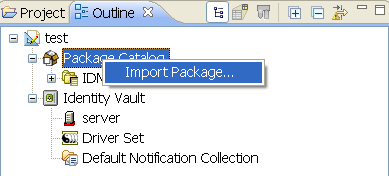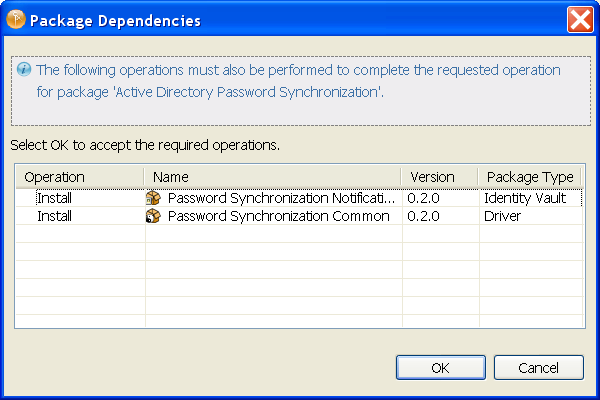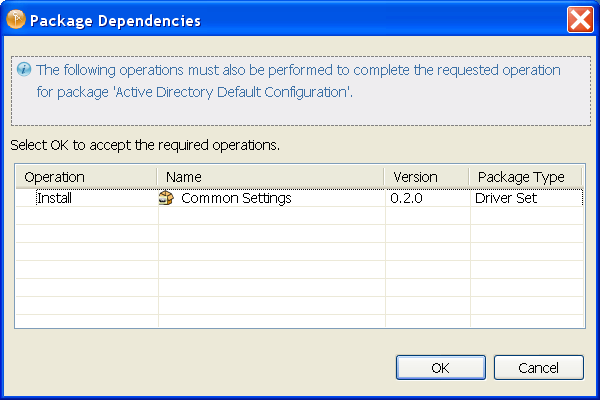4.2 Creating the Driver in Designer
You create the Active Directory driver by installing the driver packages and then modifying the configuration to suit your environment. After you create and configure the driver, you need to deploy it to the Identity Vault and start it.
4.2.1 Importing the Current Driver Packages
Driver packages can be updated at any time and are stored in the Package Catalog. Packages are initially imported into the Package Catalog when you create a project, import a project, or convert a project. It is important to verify you have the latest packages imported into the Package Catalog before you install the driver.
To verify you have the latest packages imported into the Package Catalog:
-
Open Designer.
-
In the toolbar click > .
-
Click if there are no package update
or
Click to import the package updates.
-
In the Outline view, right-click the Package Catalog.
-
Click .

-
Select the Active Directory packages
or
Click to import all of the packages displayed, then click .
By default, only the base packages are displayed. Deselect to display all packages.
-
Click to import the selected packages, then click in the successfully imported packages message.
-
After the current packages are imported, continue with Section 4.2.2, Installing the Driver Packages.
4.2.2 Installing the Driver Packages
After you have imported the current driver packages into the Package Catalog, you can install the driver packages to create a new driver.
-
In Designer, open your project.
-
In the Modeler, right-click the driver set where you want to create the driver, then select > .
-
Select from the list of base packages, then click .
-
Select the optional features to install for the Active Directory driver. All options are selected by default. The options are:
Default Configuration: This package contains the default configuration information for the Active Directory driver. Always leave this option selected.
Entitlements and Exchange Mailbox Support: This package contains configuration information for synchronizing Exchange Mailbox accounts and policies that enable account creation and auditing for the Active Directory driver. If you want account creation and auditing enabled, verify that this option is selected. For more information, see the Identity Manager 4.0.1 Entitlements Guide.
Password Synchronization: This packages contains the policies that enable the Active Directory driver to synchronize passwords. If you want to synchronize passwords, verify that this option is selected. For more information, see the Identity Manager 4.0.1 Password Management Guide.
Data Collection: This package contains the policies that enable the driver to collect data for reports. If you are using the Identity Reporting Module, verify that this option is selected. For more information, see the Identity Reporting Module Guide.
Account Tracking: This package contains the policies that enable you to track accounts for reports. If you are using the Identity Reporting Module, verify that this option is selected. For more information, see the Identity Reporting Module Guide.
-
After selecting the optional packages, click .
-
(Conditional) If there are package dependencies for the packages you selected to install, you must install them to install the selected package. Click to install the package dependencies listed.

-
(Conditional) If more than one type of package dependency must be installed, you are presented with these packages separately. Continue to click to install any additional package dependencies.

-
(Conditional) The Common Settings page is only displayed if the Common Settings package is installed as a dependency. On the Install Common Settings page, fill in the following fields:
User Container: Select the Identity Vault container where Active Directory users will be added if they don’t already exist in the vault. This value becomes the default for all drivers in the driver set.
If you want a unique location for this driver, set the value for all drivers on this page. After the driver is created, change the value on the driver’s Global Configuration Values page.
Group Container: Select the Identity Vault container where Active Directory groups will be added if they don’t already exist in the vault. This value becomes the default for all drivers in the driver set.
If you want a unique location for this driver, set the value for all drivers on this page. After the driver is created, change the value on the driver’s Global Configuration Values page.
-
Click .
-
On the Install Active Directory Base page, fill in the following field for the driver information:
Driver Name: Specify a name for the driver that is unique within the driver set.
-
Click .
-
On the Install Active Directory Base page, fill in the following fields to authenticate to Active Directory:
Authentication ID: Specify an Active Directory account with administrative privileges to be used by Identity Manager. The form of the name used depends on the selected authentication mechanism.
For , provide the name form required by your Active Directory authentication mechanism. For example:
-
Administrator: Active Directory Logon Name
-
Domain/Administrator: Domain qualified Active Directory Logon Name
Authentication Password: Provide the password for the specified Active Directory account.
Authentication Context: Specify the name of the Active Directory domain controller to use for synchronization.
For example, for the authentication method, use the DNS name (for example, mycontroller.domain.com). For the authentication method, you can use the IP address of your server (for example, 10.10.128.23 or the DNS name).
If no value is specified, localhost is used.
-
-
Click .
-
On the Install Active Directory Base page, fill in the following fields to configure the driver to connect using the Remote Loader:
Connect to Remote Loader: By default, the driver is configured to connect using the Remote Loader. If you want to run the driver locally, select , then click . Otherwise, fill in the remaining fields to configure the driver to connect by using the Remote Loader.
Host Name: Specify the hostname or IP address of the server where the driver’s Remote Loader service is running.
Port: Specify the port number where the Remote Loader is installed and is running for this driver. The default port number is 8090.
Remote Password: Specify the Remote Loader’s password as defined on the Remote Loader. The Metadirectory server (or Remote Loader shim) requires this password to authenticate to the Remote Loader
Driver Password: Specify the driver object password that is defined in the Remote Loader service. The Remote Loader requires this password to authenticate to the Metadirectory server.
-
Click .
-
On the Install Active Directory Base page, fill in the following fields to configure the driver’s synchronization settings:
Domain DNS Name: Specify the DNS name of the Active Directory domain managed by this driver.
Subscriber Channel Placement Type: Select the desired form of placement for the Subscriber channel. This option determines the Subscriber channel Placement policies.
-
mirrored: Places objects hierarchically within the base container.
-
flat: Places objects only in the base container.
Active Directory User Container: Specify the container where user objects reside in Active Directory.
Publisher Channel Placement Type: Select the desired form of placement for the Publisher channel. This option determines the Publisher channel Placement policies.
-
mirrored: Places object hierarchically within the base container.
-
flat: Places objects only in the base container.
-
-
Click .
-
(Conditional) This page is displayed only if you selected to install the Account Tracking packages. On the Install Active Directory Account Tracking page, fill in the following field:
Realm: Specify the name of the realm, security domain, or namespace where the account name is unique.
-
Click .
-
(Conditional) This page is only displayed if you selected to install the Data Collection packages and the Account Tracking packages. On the Install Active Directory Managed System Information page, fill in the following fields to define your Active Directory system:
Name: Specify a descriptive name for this Active Directory system. The name is displayed in reports.
Description: Specify a brief description for this Active Directory system. The description is displayed in reports.
Location: Specify the physical location of this Active Directory system. The location is displayed in reports.
Vendor: Leave Microsoft as the vendor of Active Directory. This information is displayed in reports.
Version: Specify the version of this Active Directory system. The version is displayed in the reports.
-
Click .
-
(Conditional) This page is displayed only if you selected to install the Data Collection packages and the Account Tracking packages. On the Install Active Directory Managed System Information page, fill in the following fields to define the ownership of the Active Directory system:
Business Owner: Select a user object in the Identity Vault that is the business owner of the Active Directory system. This can only be a user object, not a role, group, or container.
Application Owner: Select a user object in the Identity Vault that is the application owner of the Active Directory system. This can only be a user object, not a role, group, or container.
-
Click .
-
(Conditional) This page is displayed only if you selected to install the Data Collection packages and the Account Tracking packages. On the Install Active Directory Managed System Information page, fill in the following fields to define the classification of the Active Directory system:
Classification: Select the classification of the Active Directory system. This information is displayed in the reports. You options are:
-
Mission-Critical
-
Vital
-
Not-Critical
-
Other
If you select , you must specify a custom classification for the Active Directory system.
Environment: Select the type of environment the Active Directory system provides. The options are:
-
Development
-
Test
-
Staging
-
Production
-
Other
If you select , you must specify a custom classification for the Active Directory system.
-
-
Click .
-
Review the summary of tasks that will be completed to create the driver, then click .
The driver is now created. You can modify the configuration settings, by continuing with the next section, Section 4.2.3, Configuring the Driver. If you don’t need to configure the driver, continue to Section 4.2.3, Configuring the Driver.
4.2.3 Configuring the Driver
There are many settings that can help you customize and optimize the driver. The settings are divided into categories such as Driver Configuration, Engine Control Values, and Global Configuration Values (GCVs). Although it is important for you to understand all of the settings, your first priority should be to review the Driver Parameters located on the Driver Configuration page and the Global Configuration Values. These settings must be configured properly for the driver to start and function correctly.
To access the Driver Properties page:
-
Open your project.
-
In the Modeler, right-click the driver icon
 or the driver line, then select .
or the driver line, then select .
-
Modify the settings as necissary.
In addition to the driver settings, you should review the set of default policies and rules provided by the basic driver configuration. Although these policies and rules are suitable for synchronizing with Active Directory, your synchronization requirements for the driver might differ from the default policies. If this is the case, you need to change them to carry out the policies you want. The default policies and rules are discussed in Section 1.4, Default Driver Configuration.
-
Continue with Section 4.2.4, Deploying the Driver.
4.2.4 Deploying the Driver
After a driver is created in Designer, it must be deployed into the Identity Vault.
-
In Designer, open your project.
-
In the Modeler, right-click the driver icon
 or the driver line, then select .
or the driver line, then select .
-
If you are authenticated to the Identity Vault, skip to Step 5; otherwise, specify the following information:
Host: Specify the IP address or DNS name of the server hosting the Identity Vault.
Username: Specify the DN of the user object used to authenticate to the Identity Vault.
Password: Specify the user’s password.
-
Click .
-
Read through the deployment summary, then click .
-
Read the successful message, then click .
-
Click to assign rights to the driver.
The driver requires rights to objects within the Identity Vault. The Admin user object is most often used to supply these rights. However, you might want to create a DriversUser (for example) and assign security equivalence to that user. Whatever rights that the driver needs to have on the server, the DriversUser object must have the same security rights.
-
Click , then browse to and select the object with the correct rights.
-
Click twice.
-
-
Click to exclude users that should not be synchronized.
You should exclude any administrative User objects (for example, Admin and DriversUser) from synchronization.
-
Click .
4.2.5 Starting the Driver
When a driver is created, it is stopped by default. To make the driver work, you must start the driver and cause events to occur. Identity Manager is an event-driven system, so after the driver is started, it won’t do anything until an event occurs.
To start the driver:
-
In Designer, open your project.
-
In the Modeler, right-click the driver icon
 or the driver line, then select .
or the driver line, then select .
For information about management tasks for the driver, see Section 7.0, Managing Active Directory Groups and Exchange Mailboxes.